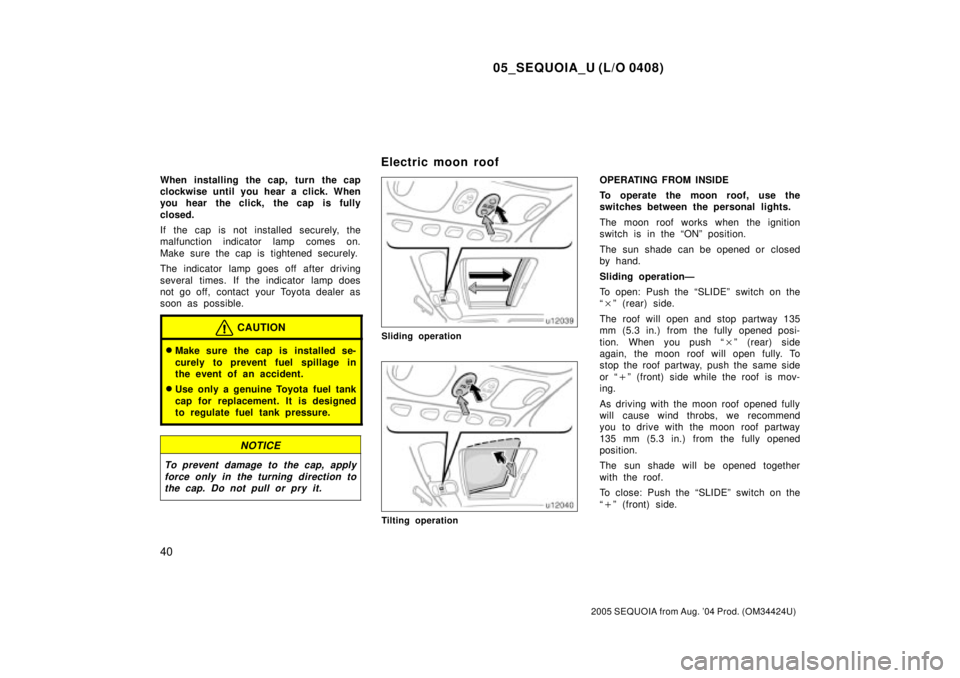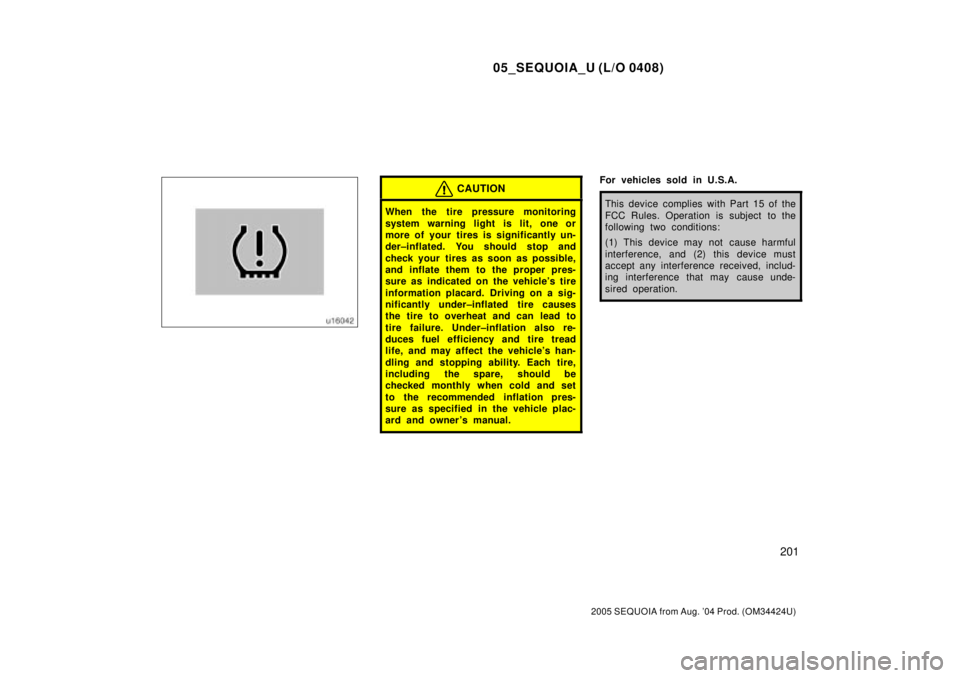Page 3869 of 4323
05_SEQUOIA_U (L/O 0408)
10
2005 SEQUOIA from Aug. '04 Prod. (OM34424U)
or
Driver 's seat belt reminder light*
1
Discharge warning light*
1
Low fuel level warning light*
1
Brake system warning light*
1
Malfunction indicator lamp*
1
Anti±lock brake system warning light*
1
Automatic transmission fluid temperature
warning light (four±wheel drive models)*
1
SRS warning light*
1
Open door warning light*
1
Low windshield washer fluid level warning
light*
1
Front passenger 's seat belt reminder light*
1
Vehicle stability control system/traction control
system (two±wheel drive models) or active
traction control system (four±wheel drive
models) warning light
*
1
Low tire pressure warning light*
1
Engine oil replacement reminder light*
1
Indicator symbols on the instrument panel
Page 3898 of 4323
05_SEQUOIA_U (L/O 0408)
39
2005 SEQUOIA from Aug. '04 Prod. (OM34424U)
1. To open the fuel filler door, pull the
lever.
When refueling, turn off the engine.
CAUTION
�Do not smoke, cause sparks or al-
low open flames when refueling.
The fumes are flammable.
�When opening the cap, do not re-
move the cap quickly. In hot weath-
er, fuel under pressure could cause
injury by spraying out of the filler
neck if the cap is suddenly re-
moved.
2. To remove the fuel tank cap, turn
the cap counterclockwise by 90 de-
grees (to the pressure point 1), and
then turn it an additional 30 degrees
(to point 2). Pause slightly before
removing it.
It is not unusual to hear a slight swoosh
when the cap is opened.3. The removed cap can be stored on
the back side of the fuel filler door.
Position the cap so that the hooks point
to the left and right, and set it in the
receptacle on the back side of the door.
Page 3899 of 4323

05_SEQUOIA_U (L/O 0408)
40
2005 SEQUOIA from Aug. '04 Prod. (OM34424U)
When installing the cap, turn the cap
clockwise until you hear a click. When
you hear the click, the cap is fully
closed.
If the cap is not installed securely, the
malfunction indicator lamp comes on.
Make sure the cap is tightened securely.
The indicator lamp goes off after driving
several times. If the indicator lamp does
not go off, contact your Toyota dealer as
soon as possible.
CAUTION
�Make sure the cap is installed se-
curely to prevent fuel spillage in
the event of an accident.
�Use only a genuine Toyota fuel tank
cap for replacement. It is designed
to regulate fuel tank pressure.
NOTICE
To prevent damage to the cap, apply
force only in the turning direction to
the cap. Do not pull or pry it.
Sliding operation
Tilting operation
OPERATING FROM INSIDE
To operate the moon roof, use the
switches between the personal lights.
The moon roof works when the ignition
switch is in the ªONº position.
The sun shade can be opened or closed
by hand.
Sliding operationÐ
To open: Push the ªSLIDEº switch on the
ª�º (rear) side.
The roof will open and stop partway 135
mm (5.3 in.) from the fully opened posi-
tion. When you push ª�º (rear) side
again, the moon roof will open fully. To
stop the roof partway, push the same side
or ª�º (front) side while the roof is mov-
ing.
As driving with the moon roof opened fully
will cause wind throbs, we recommend
you to drive with the moon roof partway
135 mm (5.3 in.) from the fully opened
position.
The sun shade will be opened together
with the roof.
To close: Push the ªSLIDEº switch on the
ª�º (front) side.
Electric moon roof
Page 4016 of 4323
05_SEQUOIA_U (L/O 0408)
157
2005 SEQUOIA from Aug. '04 Prod. (OM34424U)
OPERATION OF INSTRUMENTS AND
CONTROLS
Gauges, Meters and Service reminder indicators
Fuel gauge158 . . . . . . . . . . . . . . . . . . . . . . . . . . . . . . . . . . . . . . . . . . . . . . . .
Engine coolant temperature gauge158 . . . . . . . . . . . . . . . . . . . . . . . . . . .
Oil pressure gauge159 . . . . . . . . . . . . . . . . . . . . . . . . . . . . . . . . . . . . . . . . .
Vo ltme te r160 . . . . . . . . . . . . . . . . . . . . . . . . . . . . . . . . . . . . . . . . . . . . . . . . . .
Tachometer160 . . . . . . . . . . . . . . . . . . . . . . . . . . . . . . . . . . . . . . . . . . . . . . . .
Odometer and two trip meters160 . . . . . . . . . . . . . . . . . . . . . . . . . . . . . . . .
Service reminder indicators and warning buzzers162 . . . . . . . . . . . . . .
SECTION 1± 6
Page 4029 of 4323

05_SEQUOIA_U (L/O 0408)
170
2005 SEQUOIA from Aug. '04 Prod. (OM34424U)
CHECKING SERVICE REMINDER
INDICATORS (except the low fuel level
warning light and low windshield
washer fluid level warning light)
1. Apply the parking brake.
2. Open one of the side doors or back
door.
The open door warning light should
come on.
3. Close the door.
The open door warning light should go
off.
4. Turn the ignition key to ªONº, but do
not start the engine.
All the service reminder indicators ex-
cept the open door warning light should
come on. The ªABSº and ªVSC TRACº
warning lights, low tire pressure warn-
ing light and engine oil replacement
reminder light go off after a few sec-
onds. The SRS warning light goes off
after about 6 seconds. (The ªTRAC
OFFº (two±wheel drive models) or
ªVSC OFFº (four±wheel drive models),
ªRSCA OFFº indicator lights, height
control indicator light, manual control
mode indicator light and slip indicator
light also come on and go off after a
few seconds.)If any service reminder indicator or warn-
ing buzzer does not function as described
above, have it checked by your Toyota
dealer as soon as possible.
Page 4060 of 4323

05_SEQUOIA_U (L/O 0408)
201
2005 SEQUOIA from Aug. '04 Prod. (OM34424U)
CAUTION
When the tire pressure monitoring
system warning light is lit, one or
more of your tires is significantly un-
der±inflated. You should stop and
check your tires as soon as possible,
and inflate them to the proper pres-
sure as indicated on the vehicle's tire
information placard. Driving on a sig-
nificantly under±inflated tire causes
the tire to overheat and can lead to
tire failure. Under±inflation also re-
duces fuel efficiency and tire tread
life, and may affect the vehicle's han-
dling and stopping ability. Each tire,
including the spare, should be
checked monthly when cold and set
to the recommended inflation pres-
sure as specified in the vehicle plac-
ard and owner 's manual.
For vehicles sold in U.S.A.
This device complies with Part 15 of the
FCC Rules. Operation is subject to the
following two conditions:
(1) This device may not cause harmful
interference, and (2) this device must
accept any interference received, includ-
ing interference that may cause unde-
sired operation.
Page 4211 of 4323

05_SEQUOIA_U (L/O 0408)
352
2005 SEQUOIA from Aug. '04 Prod. (OM34424U)
Ti r e relat ed ter mMeaning
Accessory weight
the combined weight (in excess of those standard items which may be
replaced) of automatic transmission, power steering, power brakes, power
windows, power seats, radio, and heater, to the extent that these items
are available as factory±installed equipment (whether installed or not)
Cold tire inflation pressure
tire inflation pressure when the vehicle has been parked for at least 3
hours or more, or it has not been driven more than 1.5 km or 1 mile
under that condition
Curb weight
the weight of a motor vehicle with standard equipment including the
maximum capacity of fuel, oil, and coolant, and, if so equipped, air
conditioning and additional weight optional engine
Intended outboard sidewall
(A) the sidewall that contains a whitewall, bears white lettering or bears
manufacturer, brand, and/or model name molding that is higher or
deeper than the same molding on the other sidewall of the tire, or
(B) the outward facing sidewall of an asymmetrical tire that has a particular
side that must always face outward when mounted on a vehicle
Maximum inflation pressurethe maximum cold inflation pressure to which a tire may be inflated and it
is shown on the sidewall of the tire
Maximum loaded vehicle weight
the sum ofÐ
(a) curb weight;
(b) accessory weight;
(c) vehicle capacity weight; and
(d) production options weight
ÐGlossary of tire terminology
Page 4237 of 4323

05_SEQUOIA_U (L/O 0408)
378
2005 SEQUOIA from Aug. '04 Prod. (OM34424U)
Improving fuel economy is easyÐjust take
it easy. It will help make your vehicle last
longer, too. Here are some specific tips
on how to save money on both fuel and
repairs:
�Keep your tires inflated at the cor-
rect pressure. Underinflation causes
tire wear and wastes fuel. See page
429 in Section 7±2 for instructions.
�Do not carry unneeded weight in
your vehicle. Excess weight puts a
heavier load on the engine, causing
greater fuel consumption.
�Avoid lengthy warm±up idling. Once
the engine is running smoothly, begin
drivingÐbut gently. Remember, howev-
er, that on cold winter days this may
take a little longer.
�Keep the automatic transmission
overdrive turned on when engine
braking is not required. Driving with
the overdrive off will reduce the fuel
economy. (For details, see ªAutomatic
transmissionº on page 173 in Section
1±7.)
�Accelerate slowly and smoothly.
Avoid jackrabbit starts. Get into high
gear as quickly as possible.
�Avoid long engine idling. If you have
a long wait and you are not in traffic,
it is better to turn off the engine and
start again later.
�Avoid engine lugging or over±rev-
ving. Use a gear position suitable for
the road on which you are travelling.
�Avoid continuous speeding up and
slowing down. Stop±and±go driving
wastes fuel.
�Avoid unnecessary stopping and
braking. Maintain a steady pace. Try
to time the traffic signals so you only
need to stop as little as possible or
take advantage of through streets to
avoid traffic lights. Keep a proper dis-
tance from other vehicles to avoid sud-
den braking. This will also reduce wear
on your brakes.
�Avoid heavy traffic or traffic jams
whenever possible.
�Do not rest your foot on the brake
pedal. This causes premature wear,
overheating and poor fuel economy.
�Maintain a moderate speed on high-
ways. The faster you drive, the greater
the fuel consumption. By reducing your
speed, you will cut down on fuel con-
sumption.
�Keep the front wheels in proper
alignment. Avoid hitting the curb and
slow down on rough roads. Improper
alignment not only causes faster tire
wear but also puts an extra load on
the engine, which, in turn, wastes fuel.
�Keep the bottom of your vehicle free
from mud, etc. This not only lessens
weight but also helps prevent corro-
sion.
�Keep your vehicle tuned±up and in
top shape. A dirty air cleaner, improp-
er valve clearance, dirty plugs, dirty oil
and grease, brakes not adjusted, etc.
all lower engine performance and con-
tribute to poor fuel economy. For longer
life of all parts and lower operating
costs, keep all maintenance work on
schedule, and if you often drive under
severe conditions, see that your vehicle
receives more frequent maintenance.
(For scheduled maintenance informa-
tion, please refer to the ªScheduled
Maintenance Guideº or ªOwner 's Manu-
al Supplementº.)
How to save fuel and make
your vehicle last longer